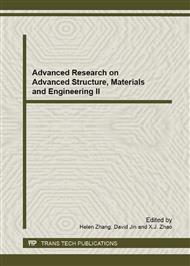[1]
E. Weichselbaum: Probiotics and health: a review of the evidence. British Nutrition Foundation Nutrition Bulletin, Vol.34 (2009), p.340–373
DOI: 10.1111/j.1467-3010.2009.01782.x
Google Scholar
[2]
Canani RB, Cirillo P, Terrin G et al. Probiotics for treatment of acute diarrhoea in children: a randomised clinical trial of five different preparations. BMJ, Vol. 335(2007), p.340.
DOI: 10.1136/bmj.39272.581736.55
Google Scholar
[3]
Ishida Y, Nakamura F, Kanzato H.: Clinical effects of Lactobacillus acidophilus strain L-92 on perennial allergic rhinitis: a double-blind, placebo-controlled study. Journal of Dairy Science, Vol. 88 (2005), p.527–533.
DOI: 10.3168/jds.s0022-0302(05)72714-4
Google Scholar
[4]
Yoshibumi Miyazaki,Shigeru Kamiya,Tomoko Hanawa: Effect of probiotic bacterial strains of Lactobacillus, Bifidobacterium, and Enterococcus on enteroaggregative Escherichia coli. J Infect Chemother, 2007
DOI: 10.1007/s10156-009-0007-2
Google Scholar
[5]
Nancy Toedter Williams: Probioitics. Am J Health-Syst Pharm. 2010, Vol 67, pp.449-459
Google Scholar
[6]
Beausoleil M, Fortier N, Guénette S.: Effect of a fermented milk combining Lactobacillus acidophilus Cl1285 and Lactobacillus casei in the prevention of antibiotic-associated diarrhea: a randomized, double-blind, placebo-controlled trial. Canadian Journal of Gastroenterology,Vol. 21 (2007): p.732–736.
DOI: 10.1155/2007/720205
Google Scholar
[7]
Ana M.P. Gomes, F. Xavier Malcata: Bifidobacterium spp. And Lactobacillus acidophilus: biological, biochemical, technological and therapeutical properties relevant for use as probiotics. Trends in Food Science & Technology, Vol.10 (1999), pp.139-157
DOI: 10.1016/s0924-2244(99)00033-3
Google Scholar
[8]
Lori Kopp-Hoolihan: Prophylactic and Therapeutic Uses of Probiotics: A review. Journal of the American Dietetic Association, 2001, Vol. 101, Issue 2, pp.229-241
DOI: 10.1016/s0002-8223(01)00060-8
Google Scholar
[9]
Márcia R. Silvaa, Glauce Diasb, Célia L.L.F. Ferreirac, Sylvia C.C. Franceschinib and Neuza M.B. Costab: Growth of preschool children was improved when fed an iron-fortified fermented milk beverage supplemented with Lactobacillus acidophilus. Nutrition Research, 2008,Vol. 28, Issue 4, pp.226-232.
DOI: 10.1016/j.nutres.2008.02.002
Google Scholar
[10]
Harsharnjit S. Gill bvsc, mvsc: Probiotics to enhance anti-infective defences in the gastrointestinal tract. Research Clinical Gastroenterology, 2003, Vol. 17, Issue 5, pp.755-773
DOI: 10.1016/s1521-6918(03)00074-x
Google Scholar
[11]
Eun Y. Ann, Younghoon Kim, Sejong Oh, Jee-Young Imm, Dong-Jun Park, Kyoung S. Han, Sae H. Kim1: Microencapsulation of Lactobacillus acidophilus ATCC 43121 with prebiotic substrates using a hybridisation system
DOI: 10.1111/j.1365-2621.2007.01236.x
Google Scholar
[12]
M.E. Sanders, T.R. Klaenhammer: Invited Review: The Scientific Basis of Lactobacillus acidophilus NCFM Functionality as a Probiotic . Journal of Dairy Science, 2001, Vol. 84, Issue 2, pp.319-331
DOI: 10.3168/jds.s0022-0302(01)74481-5
Google Scholar
[13]
Elizabeth W. Nga, Marie Yeung: Effects of yogurt starter cultures on the survival of Lactobacillus acidophilus. International Journal of Food Microbiology, 2011, Vol. 145, Issue 1, pp.169-175
DOI: 10.1016/j.ijfoodmicro.2010.12.006
Google Scholar
[14]
Djamel Fahloul, Miloud Lahbari, Houcine Benmoussa and Samir Mezdour: Effect of osmotic dehydration on the freeze drying kinetics of apricots. Journal of Food, Agriculture & Environment 2009, Vol.7, Issue 2, pp.117-121.
Google Scholar


